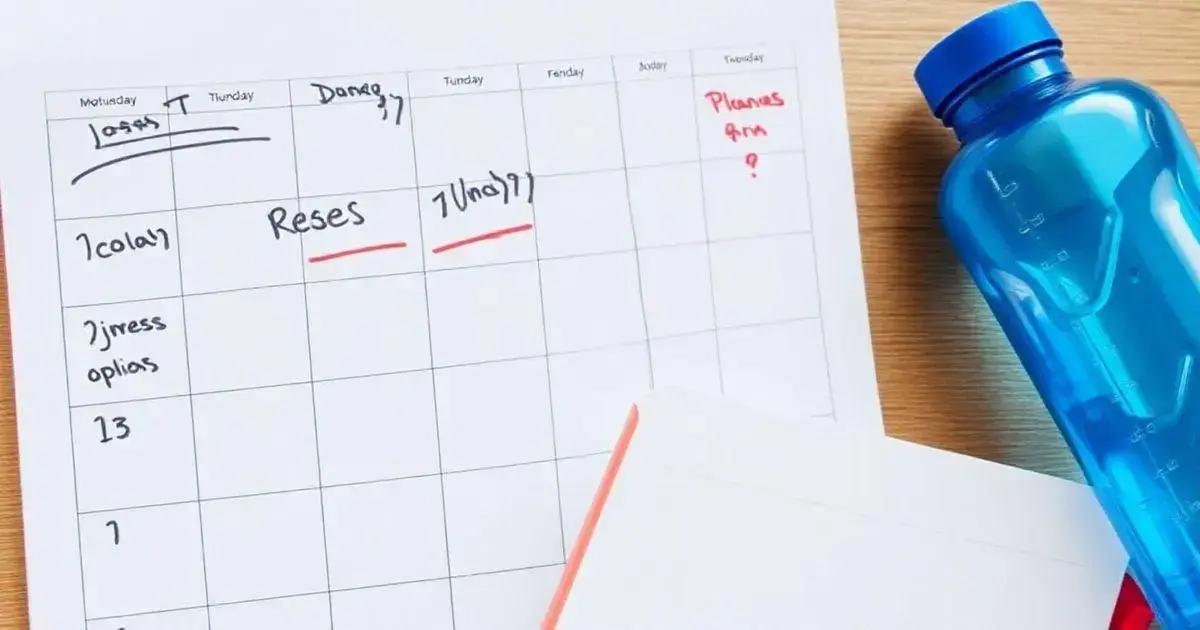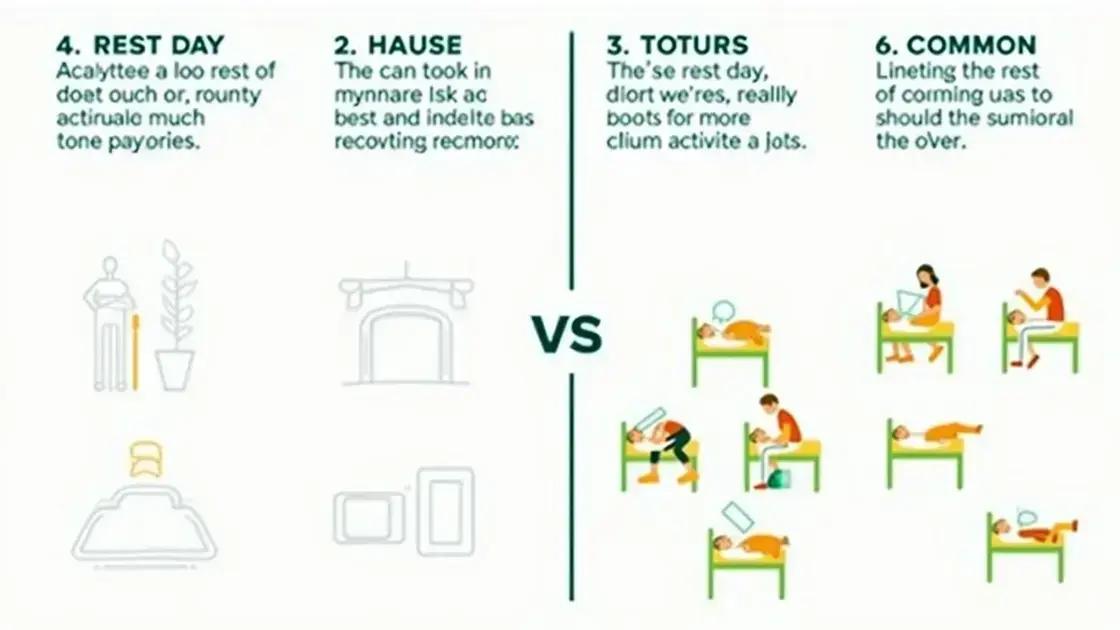The importance of rest days in your fitness routine is crucial for recovery, muscle growth, and overall performance. Incorporating regular rest helps prevent injuries, improves mental health, and allows your body to adapt to training stress, making it essential for athletes of all levels.
Rest days play a crucial role in any fitness routine. When we exercise, our bodies undergo stress, leading to micro-tears in muscles. While working out is vital for progress, the importance of rest days cannot be overlooked. They not only enhance recovery, improve performance, but also prevent injuries. In this article, we will explore the significance of rest days, the benefits they provide, how to incorporate them into your regimen, and debunk common myths surrounding them.
Understanding Rest Days and Recovery

Understanding the Role of Rest Days in a fitness routine is essential for making progress and improving overall health. When you work out, you stress your muscles, leading to tiny tears in muscle fibers. This is part of the natural process that helps muscles grow stronger. Rest days allow your body the time it needs to repair these muscles and recover.
During rest periods, your body is busy healing. It repairs muscle tissues, restores energy reserves, and removes waste products built up during intense training. Without proper recovery, you may feel fatigued, and your performance may decline. This recovery time is critical if you want to achieve your fitness goals.
How Rest Affects Performance
Rest days can lead to better workouts overall. When your body is well-rested, you can train harder and more effectively. This stress on your muscles is what builds strength and endurance. Consequently, integrating rest days into your fitness plan could enhance your workouts and lead to better results.
Types of Recovery Days
Rest days don’t mean doing nothing at all. There are active recovery days that include light activities such as walking, yoga, or gentle stretching. These activities can help maintain blood flow to your muscles and promote healing without putting you under stress. Listen to your body; it will let you know when you need a complete break versus when you need just some light activity.
An essential aspect of understanding rest days is recognizing the difference between physical and mental fatigue. Sometimes, your mind may need a break, even if your body feels fine. Taking time off not only aids physical recovery but also helps prevent burnout and keeps you motivated for your fitness journey.
Benefits of Taking Rest Days

Taking rest days provides numerous benefits that can improve your fitness journey. One of the main advantages is muscle recovery. Your muscles need time to heal and strengthen after workouts. By allowing rest days, you can prevent overuse injuries and ensure optimal performance during your training sessions.
Another significant benefit is the enhancement of mental health. Constantly pushing your body can lead to burnout. Rest days help in reducing stress and anxiety, giving you the mental break you need. They also provide an opportunity to recharge mentally, enabling you to stay motivated and focused on your goals.
Improved Performance
Rest days can actually lead to better performance overall. When you return to your workouts well-rested, you’ll often find you can lift heavier weights, run faster, or endure longer sessions without feeling exhausted. This improvement comes from the muscle repair that occurs during rest.
Enhanced Immune Function
Your immune system also benefits from taking scheduled rest. Intense workouts can lead to temporary decreases in immune function. Incorporating rest days helps maintain a strong immune system, allowing you to stay healthy and avoid getting sick during your training period.
Better Sleep Quality
Regularly including rest days can also improve your sleep quality. Exercise can sometimes negatively affect sleep patterns, especially if you’re working out too intensely every day. By balancing hard training with adequate rest, your body can better regulate sleep cycles, resulting in deeper, more restful sleep.
How to Incorporate Rest Days

Incorporating rest days into your fitness routine is vital for recovery. Start by planning your rest days in advance. Consider scheduling them as you would any other workout. This helps ensure you don’t skip them. For most people, resting at least one to two days a week is necessary.
Listen to Your Body. It’s essential to listen to your body. If you’re feeling overly fatigued or sore, it might be a sign to take an extra rest day. Pay attention to signs of exhaustion, such as decreased performance or mood changes, and adjust your schedule accordingly.
Mixing Active and Complete Rest
Rest days don’t always mean inactivity. Active rest days can include going for a light walk, stretching, or practicing yoga. These activities keep your body moving without the intensity of your regular workouts. Integrate both complete rest days and active recovery days based on how your body feels.
Consider Your Workout Schedule
When planning your rest days, consider the intensity of your workouts. After a challenging week of heavy lifting or high-endurance training, a rest day can be especially beneficial. Conversely, if you have easier workouts scheduled, you might not need as many rest days. Tailor your approach based on the demands of your fitness plan.
Document Your Progress
Maintaining a fitness journal can help you see patterns in your performance and recovery. Write down your workouts, how you feel, and how much rest you take. This data will help you understand when to rest and how your body reacts to exercise and recovery.
Common Myths About Rest Days

There are many myths about rest days that can mislead people trying to improve their fitness. One common myth is that taking rest days means you are lazy. In reality, rest days are essential for recovery and muscle growth. They allow your body to heal and prepare for future workouts.
Another myth is that resting too much can lead to loss of strength. While it’s true that continuous training is important, it’s equally important to recognize that without rest, your performance will suffer. Overtraining can actually weaken your muscles and overall fitness levels.
Only Beginners Need Rest Days
A persistent myth is that only beginners need to take rest days. This belief is false; all fitness levels benefit from rest. Even elite athletes require scheduled breaks to ensure peak performance and prevent injuries. Everyone’s body needs time to recover, regardless of experience.
Rest Days Have No Impact on Progress
Some people think rest days do not affect progress. However, adequate recovery is vital for allowing your body to adapt and improve. Without proper rest, your muscles can’t rebuild, which may stall your progress. Taking days off positively impacts your results in the long run.
Active Recovery Isn’t a Real Rest Day
Many believe that any form of activity on a rest day negates the benefits of resting. However, active recovery can be an effective way to stay loose and promote healing. Gentle activities like walking or stretching help maintain circulation without putting strain on your body.
The Importance of Incorporating Rest Days in Your Fitness Routine
Understanding the significance of rest days is crucial for anyone on a fitness journey. By recognizing the importance of recovery, you can enhance your performance, improve your health, and achieve better results.
Incorporating rest days not only aids muscle recovery but also supports mental well-being, ensuring that you remain motivated and focused. Dispelling common myths about rest days can help you make informed decisions about your training schedule and overall approach to fitness.
Ultimately, balance is key—mixing workout intensity with adequate rest will lead to sustainable progress and a healthier lifestyle. Take the time to rest; your body will thank you.
FAQ – Frequently Asked Questions About Rest Days in Your Fitness Routine
Why are rest days important in a fitness routine?
Rest days are crucial for muscle recovery, preventing injuries, and improving overall performance. They allow your body to heal and grow stronger.
How often should I take rest days?
Most fitness experts recommend taking one to two rest days per week, depending on the intensity of your workouts and how your body feels.
Can I be active on my rest days?
Yes! Active recovery such as light walking, stretching, or yoga can help maintain circulation and promote healing without straining your body.
What are some common myths about rest days?
Common myths include the beliefs that rest days mean laziness, that only beginners need them, and that they hinder progress. In reality, rest is essential for recovery.
How can I tell if I need an extra rest day?
If you experience excessive fatigue, soreness, or lack of motivation, it may be a sign that your body needs an extra rest day to recover.
What should I do on a rest day?
On a rest day, consider engaging in light activities such as walking, doing yoga, stretching, or simply relaxing to allow your body to recover properly.













